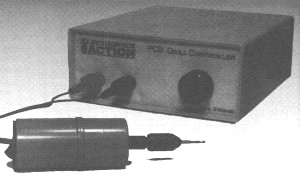 The speed controller
in this article overcomes this problem by raising the voltage to the drill
as the load is increased. The unit uses a basic Pulse Width Modulation
(PWM) regulator to reduce the power dissipation.
The speed controller
in this article overcomes this problem by raising the voltage to the drill
as the load is increased. The unit uses a basic Pulse Width Modulation
(PWM) regulator to reduce the power dissipation.This unit was designed for the Expo Reliant drill. This popular low cost tool is ideally suited to light duty use.
The controller can power other small PCB drills, as well as other devices containing small 12 Volt DC motors, although some changes to component values may be necessary.
The Works
The circuit diagram is shown in fig *.
IC1 acts as an oscillator, running at several KHz. The pulses from this briefly turn on TR1, which discharges C4. Between these pulses C4 charges via R5, producing a rough sawtooth waveform.
This sawtooth is connected to one input of a comparator circuit IC3, while the other input is fed from a reference voltage. The output of the comparator controls the switching transistor TR5, via TR3 and TR4.
Thus as the reference voltage is increased, the switching transistor is turned on for a longer period, and the drive to the drill is increased.
VR1 is the front panel speed control, the voltage from which is buffered by TR2, and fed to the reference input of the comparator circuit by VR2.
R15 senses the current flowing in the drill. The peak voltage across this is amplified by IC2, the output from which is also fed to the reference input of the comparator via VR2.
Thus as the load on the drill increases, its current consumption raises, which in turn causes this unit to increase the drive to the drill. VR2 sets the ratio of control to feedback.
FU1 will blow if the drill is stalled for long period, or if the output is short-circuited. Since the circuit can withstand the short circuit current until the fuse blows, a more elaborate over-current circuit is not necessary.
Construction
 The
circuit is assembled on a single sided PCB, 126mm * 56mm. There is nothing
out of the ordinary about the PCB construction, the components are fitted
in the usual size order.
The
circuit is assembled on a single sided PCB, 126mm * 56mm. There is nothing
out of the ordinary about the PCB construction, the components are fitted
in the usual size order.A small heatsink may be fitted to TR5 if desired. This runs cool in normal operation, but will heat up if the output is short-circuited until the fuse blows.
R15 will run warm in normal operation and should be mounted a few millimetres above the surface of the PCB. The 2 Watt power rating suggested in the parts list should be regarded as a minimum.
The prototype was built in a plastic case, 190mm * 165mm * 68mm, see parts list for details. Check the dimensions of the transformer before buying the case. A suitable overlay for the front panel is shown in fig *, this may be photocopied and fixed to the front panel with clear self-adhesive vinyl.
The internal layout can be seen in the photographs and the interwiring is shown in fig *. No mains fuse or switch were fitted on the prototype for simplicity, however a 3A fuse was fitted in the main's plug.
Testing
Ensure that main's connections within the unit are well insulated for safety. Set VR1 fully anti-clockwise and VR2 fully clockwise. Connect the unit to the mains and switch on. Connect the PCB drill to the output terminals.
As VR1 is turned clockwise, the speed of the drill should increase. Set this control to about one quarter, then load the drill lightly by placing a finger against the chuck. Note how much the drill slows.
Now gradually turn VR2 anti-clockwise. The speed of the drill will increase a little. If the drill is lightly loaded again, the speed should remain more constant.
If VR2 is set too far anti-clockwise the speed control will have little effect and the drill speed may pulsate. The suggested position for VR2 is a little more clockwise than halfway.
The unit is now fully tested and can be put into use.
Parts
Resistors (All 0.25W 5% unless stated)
R1 560R 0.5W
R2,4,8-10,13,14 1K0
R3,6,7 10K
R5 220K
R11 270R
R12 22K
R15 1R5 2W
VR1 50K Horizontal Preset
VR2 50K Lin Rotary Pot
Capacitors
C1 2200u 25V Radial
C2 100n 0.2" Pitch
C3 2n2 0.2" Pitch
C4 10n 0.2" Pitch
C5 220u 10V Radial
C6,8 1u0 25V Radial
C7 100u 16V Radial
Semiconductors
IC1 555
IC2,3 CA3140
TR1-3 BC548
TR4 BC558
TR5 TIP32 or TIP42
D1,2,6 1N5401
D3 1N4148
D4 5V6 Zener
D5 OA47
Miscellaneous
X1 12-0-12V 25VA Transformer
FU1 20mm 2A Anti-Surge with PCB Fuse Holder
PCB, Case, Knob for VR1, Red and Black 4mm Terminals, Mains Flex, Expo Reliant PCB Drill.